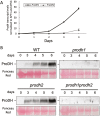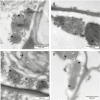Proline oxidation fuels mitochondrial respiration during dark-induced leaf senescence in Arabidopsis thaliana
- PMID: 31504781
- PMCID: PMC6859731
- DOI: 10.1093/jxb/erz351
Proline oxidation fuels mitochondrial respiration during dark-induced leaf senescence in Arabidopsis thaliana
Abstract
Leaf senescence is a form of developmentally programmed cell death that allows the remobilization of nutrients and cellular materials from leaves to sink tissues and organs. Among the catabolic reactions that occur upon senescence, little is known about the role of proline catabolism. In this study, the involvement in dark-induced senescence of proline dehydrogenases (ProDHs), which catalyse the first and rate-limiting step of proline oxidation in mitochondria, was investigated using prodh single- and double-mutants with the help of biochemical, proteomic, and metabolomic approaches. The presence of ProDH2 in mitochondria was confirmed by mass spectrometry and immunogold labelling in dark-induced leaves of Arabidopsis. The prodh1 prodh2 mutant exhibited enhanced levels of most tricarboxylic acid cycle intermediates and free amino acids, demonstrating a role of ProDH in mitochondrial metabolism. We also found evidence of the involvement and the importance of ProDH in respiration, with proline as an alternative substrate, and in remobilization of proline during senescence to generate glutamate and energy that can then be exported to sink tissues and organs.
Keywords: Arabidopsis thaliana; dark-induced leaf senescence; mitochondria; primary metabolism; proline dehydrogenase; proline metabolism.
© The Author(s) 2019. Published by Oxford University Press on behalf of the Society for Experimental Biology.
Figures









References
-
- Alonso JM, Stepanova AN. 2003. T-DNA mutagenesis in Arabidopsis. Methods in Molecular Biology 236, 177–188. - PubMed
-
- Atkinson DE. 1977. Cellular energy metabolism and its regulation. New York: Academic Press.
Publication types
MeSH terms
Substances
LinkOut - more resources
Full Text Sources
Molecular Biology Databases

